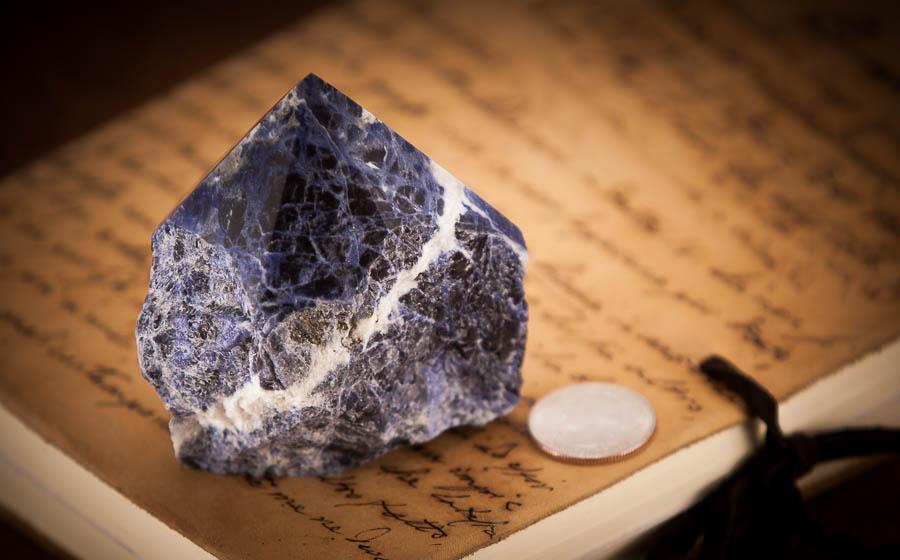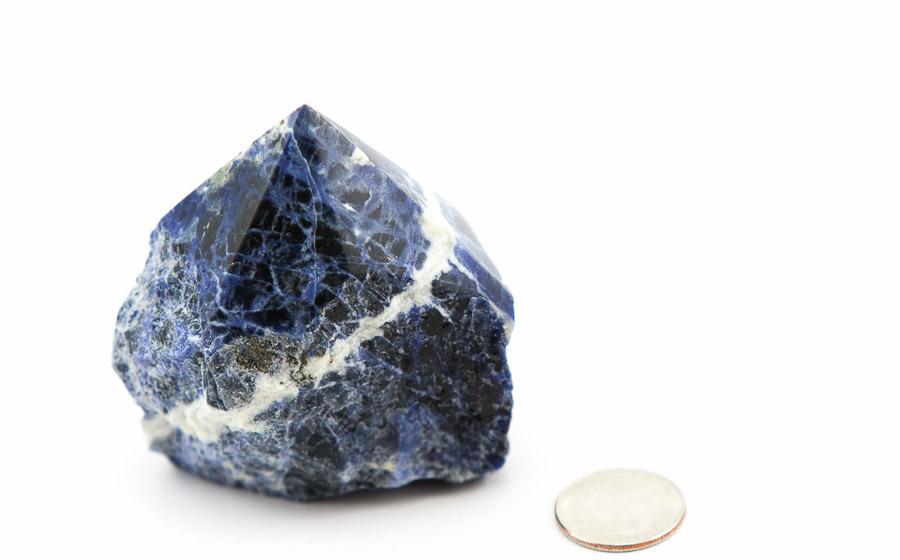You will not be allowed to compare more than 4 products at a time
View compareSodalite Top Polished Point
Sodalite Top Polished Point
Estimate delivery times:5-8 days.
Flat Rate Shipping and FREE Shipping on orders more than $100.
About This Product
Sodalite – The Royal Blue Stone of Intuition and Logic
Appearance and Aesthetic
Sodalite immediately captivates with its rich royal to navy blue color, marbled by snowy-white calcite veins that dance across its surface. Often likened to a piece of midnight sky or a storm-tossed ocean frozen in stone, it sometimes reveals subtle hints of violet or gray amid the blue. No two pieces are alike – each stone’s pattern of white streaks and patches is unique, creating striking contrasts that catch the eye. When polished, Sodalite’s surface takes on a gentle sheen that highlights its bold hues; when left raw, it has a naturally grainy matte look, with an almost velvety darkness. Smooth to the touch yet with a slightly waxy feel, a chunk of sodalite feels cool and “soapy” in hand – as if the stone itself were a piece of carved soap, owing to its characteristic oily luster. This combination of deep color and intriguing texture gives sodalite an alluring presence that invites both visual admiration and tactile curiosity.
History and Cultural Significance
Discovered relatively recently in 1811 in the wilds of Greenland, Sodalite is a newcomer compared to ancient gemstones. It remained little more than a geological curiosity until 1891, when large deposits were found in Ontario, Canada. Its big break into fame came in 1901: legend tells that during a royal visit to Bancroft, Ontario, the Princess of Wales fell in love with sodalite’s stunning blue-and-white beauty. So enchanted was the princess that she had 130 tons of it shipped back to England to adorn Marlborough House (her London residence). In honor of this royal enthusiasm, the Canadian source was proudly dubbed the “Princess Sodalite Mine” – a name it still carries today. From that moment, sodalite transformed from obscure mineral to fashionable stone, gracing Victorian parlors and fine carvings.
This gemstone also carries a reputation as a symbol of rational thought and creative inspiration. In modern lore it earned nicknames like the “Thinker’s Stone” and the “Poet’s Stone,” said to represent logic, truth, and the muse of art. Sodalite’s combination of intellectual blue and unpredictable white veins made it emblematic of bridging reason with imagination – a trait appreciated by artists, writers, and philosophers throughout the 20th century. Although not known to ancient civilizations, today sodalite stands as a stone that connects royal history, artistry, and the quest for wisdom, cherished in both museums and modern collections alike.
Metaphysical Meaning and Symbolism
Deeply insightful and soothing, sodalite has become a favorite in spiritual and metaphysical circles for its reputed ability to clear the mind and calm the soul. It is often said to awaken the “third eye” chakra – the energy center of intuition – bringing mental clarity, enhanced insight, and intuitive perception to those who meditate with it. At the same time, this stone resonates strongly with the throat chakra, encouraging truthful communication and authentic self-expression. By balancing these two chakras, sodalite is thought to harmonize logic with intuition – helping one speak truths discovered within and foster a balance between head and heart.
Spiritually, sodalite is revered as a stone of wisdom, truth, and inner peace. Many believe that it soothes anxiety and fear, making it a powerful ally against panic attacks or a racing mind. Its gentle vibrations are said to quiet emotional turmoil, instilling a sense of calm stability even in the midst of chaos. This calming effect can empower one to release stress and negative thought patterns, clearing the way for rational thought and objectivity. Sodalite’s energy is also associated with deepening intuition and psychic insight – it encourages you to trust your inner voice and seek the truth in all situations. For those on a path of spiritual growth, sodalite serves as a guiding beacon, illuminating the mind’s eye while keeping one grounded in reality. In crystal healing communities it is often recommended for anyone looking to bolster their self-confidence, philosophical understanding, or creativity, as it’s believed to inspire the bearer to tap into their inner wisdom and express it with clarity. In essence, sodalite’s metaphysical symbolism centers on insight, logic, calm, and truthful communication – a blend of qualities that nurtures both the intellect and the spirit.
Decorative and Luxury Appeal
Beyond its spiritual allure, sodalite shines in the world of art, décor, and luxury design. Its vibrant blue-and-white palette and agreeable workability have made it a sought-after medium for craftspeople and designers. From elegant jewelry to grand architectural accents, sodalite finds its way into many beautiful creations. It can be carved, polished, and set in myriad ways, each form showcasing a different aspect of its charm. Below are some of the distinctive uses of sodalite in decorative arts and luxury items:
-
Jewelry & Cabochons: Cut into smooth cabochons or beads, sodalite makes striking jewelry. Its royal blue hue, often accented by white marbling, pairs beautifully with silver or white gold. Necklaces, pendants, and earrings featuring sodalite have a naturally bold yet soothing presence, and the stone is occasionally faceted or sculpted for one-of-a-kind pieces. (Sodalite has long been used in fine jewelry as a semi-precious stone, valued for the way each piece’s pattern can resemble a tiny abstract painting.)
-
Carvings & Sculptures: Craftsmen often carve sodalite into ornamental objects and art pieces. Everything from intricate figurines and small statues to decorative bowls, vases, and obelisks have been fashioned from this stone. When polished, larger sodalite carvings exhibit a luxurious glossy finish that highlights the complex network of blue and white within. In fact, museums and galleries sometimes display sodalite carvings as examples of nature’s art; the stone’s relatively moderate hardness allows skilled lapidaries to chisel it into smooth curves and detailed shapes. These carved ornaments celebrate sodalite’s natural patterns while adding a touch of refined craftsmanship.
-
Tumbled Stones & Spheres: In metaphysical shops and collectors’ cabinets, tumbled sodalite pebbles and gleaming spheres are common treasures. Tumbled stones (small, polished river-pebble-like pieces) are popular as pocket stones or meditation aids – their soothing feel and color make them ideal for holding during prayer or stress relief. Sodalite is also shaped into crystal spheres, eggs, pyramids, or palm stones that display its colors in 360 degrees. Collectors prize these for their aesthetic appeal as well as the belief that a perfect sphere radiates energy evenly in all directions. A bowl of sodalite tumbles or a single large sphere on a stand can serve as a beautiful natural décor accent in living spaces, infusing a room with a calm, artistic vibe.
-
Luxury Inlays & Home Décor: Thanks to its dramatic look, sodalite has been employed in luxury interior design and inlays. Thin slices of sodalite are used as decorative inlays in furniture, jewelry boxes, and marquetry, creating eye-catching blue accents. In upscale homes and hotels, you might find sodalite tiles or panels adorning a tabletop, bar counter, or fireplace surround – especially the variety known as “Azul Bahia,” a sodalite-rich rock from Brazil prized as an exotic granite for its vibrant blue coloration. Such applications bring a splash of opulent color and natural beauty into interior spaces. Even small decorative items like bookends, paperweights, or lamp finials are made from sodalite to introduce a touch of gemstone luxury into everyday life.
-
Spiritual Décor & Feng Shui: For those who decorate with well-being in mind, sodalite serves as a perfect metaphysical décor piece. Meditation altars and yoga spaces often feature sodalite, whether as raw chunks or polished points, to help create a serene atmosphere. In feng shui, sodalite’s blue color is associated with the water element and is used to promote tranquility and wisdom in a room. A sodalite crystal placed in a study or workspace is thought to foster focus and intellectual flow, while in a family area it can encourage harmony and clear communication. Visually, the stone’s blend of sky-blue and cloud-white fits naturally into tranquil, contemplative design schemes.
By bridging the gap between natural elegance and human creativity, sodalite has secured its place as both a decorator’s favorite and a collector’s delight. Whether accenting a piece of jewelry or elevating the ambiance of an interior, this stone brings a unique combination of earthy beauty and refined charm to any setting.
Scientific Profile and Properties
For the geologically inclined or the educationally curious, sodalite offers a host of interesting scientific details. Below is a full scientific breakdown of Sodalite’s characteristics:
-
Chemical Composition: Na₈(Al₆Si₆O₂₄)Cl₂ – Sodalite is a sodium aluminum silicate chloride, meaning its crystal structure contains sodium, aluminum, and silicon-oxide frameworks with chloride ions locked inside. In simple terms, it’s a mineral from the feldspathoid group, chemically akin to some components of feldspar but distinguished by the presence of chlorine. This unique composition is what gives sodalite its name (from “soda,” referencing sodium content) and contributes to its vivid coloring.
-
Crystal System: Cubic (Isometric). Sodalite crystallizes in the isometric system, the same crystal system as diamonds – though well-formed sodalite crystals are quite rare. Its internal symmetry is cubic, which in theory can produce perfect dodecahedral or cubic crystals, but in nature sodalite is more often found in massive granular masses than as distinct geometric crystals.
-
Hardness: 5.5–6 on the Mohs scale. Sodalite is a relatively soft mineral in gem terms. It is about as hard as window glass or a knife blade, which means it can be scratched by harder gemstones like quartz or topaz. This moderate hardness requires some care – sodalite jewelry or carvings should be protected from rough wear to avoid scratches or chips, but it is hard enough to be shaped and polished nicely. Its tenacity is brittle, so it can crack under impact despite its crystalline strength.
-
Luster: Vitreous to greasy. When light hits sodalite, its surface typically shows a vitreous (glass-like) shine, especially on fresh broken surfaces or well-polished pieces. However, many sodalite specimens also exhibit a slight greasy or oily luster, which is why a polished piece can feel a bit like soap to the touch. This greasy luster is subtle, but it differentiates sodalite from truly glassy minerals and contributes to that soft glow rather than a sharp sparkle.
-
Transparency: Opaque (occasionally translucent). Most sodalite appears opaque to the eye, not allowing light through due to its intense color and frequent internal veining. However, in thin slivers or at the very edges of a stone, it may be translucent, allowing a dim glow of light to pass. Pure crystals (especially of colorless or light-colored sodalite) can be translucent, but gem-quality transparent sodalite is exceedingly rare. In practice, virtually all sodalite used in jewelry or décor is opaque, with just a hint of translucency in finely cut slices.
-
Cleavage: Poor, cubic cleavage. Sodalite has poor cleavage in typically six directions corresponding to its cubic symmetry. In other words, it doesn’t split cleanly along flat planes very easily (unlike, say, mica or calcite). While the underlying crystal structure could cleave at certain angles ({110} planes in the crystal lattice), any cleavage in sodalite usually appears as subtle cracks rather than smooth breaks. This poor cleavage is actually helpful for lapidaries, as it means sodalite is less likely to split unexpectedly while being cut or carved.
-
Fracture: Uneven to conchoidal. When sodalite is broken, it tends to fracture in an uneven or chunky manner, often with slightly conchoidal (shell-like curved) surfaces. You might notice chipped pieces have a lumpy or irregular texture. This type of fracture, common in quartz and glass, further gives sodalite’s broken surfaces a bit of a vitreous sheen. The combination of poor cleavage and conchoidal fracture means that rough sodalite usually occurs in massive chunks rather than flat sheets or defined crystal shapes.
-
Habit: Massive; rarely dodecahedral crystals. The typical form in which sodalite occurs is massive – as large disseminated veins or blocks within the host rock. These massive forms can be granular or compact. It’s uncommon to find sodalite as well-shaped individual crystals, but when it does crystallize freely, it often forms twelve-sided dodecahedral crystals (or sometimes truncated octahedra), reflecting its cubic symmetry. Such crystals have been found up to several centimeters in size in a few locales, but they are collector’s rarities. More often, one might see rounded nodules or embedded grains of sodalite within a matrix of other minerals. Twinning (two crystals intergrown in symmetry) can occur on the cubic planes, but again, due to sodalite’s massive habit this is usually observed microscopically. In summary, if you have a piece of sodalite, it’s most likely a part of a larger massive chunk rather than a distinct crystal point.
-
Fluorescence: Bright orange under UV. A delightful secret of sodalite is that many specimens glow under ultraviolet light. Under a UV lamp (blacklight), sodalite often fluoresces a vivid orange hue, due to sulfur-rich compounds within the mineral. In fact, a variety of sodalite known as hackmanite exhibits tenebrescence – it can temporarily change color after UV exposure (often from pale to deep purple) and then revert in the dark. This fluorescence is a handy identifying feature: enthusiastic rockhounds in Michigan’s Upper Peninsula scour beaches at night with UV lamps to find “Yooperlites,” the local nickname for sodalite-bearing rocks that light up in neon orange. While invisible in normal light, the UV glow of sodalite is a reminder of the stone’s chemical uniqueness and often amazes those seeing it for the first time.
-
Specific Gravity: Approximately 2.2 (lightweight). Sodalite has a specific gravity around 2.2 to 2.3, which makes it somewhat lighter than many other gemstones. For comparison, quartz’s specific gravity is about 2.65 and diamond’s is 3.5+. Picking up a piece of sodalite, you might be surprised that it feels a bit less hefty than a similarly sized piece of quartz or lapis lazuli. This lower density is due to the presence of lighter elements like sodium and the openness of its crystal framework. Practically, this means larger sodalite ornaments or jewelry pieces are comfortably wearable (not too heavy), and larger rough boulders of sodalite might feel “lighter than they look.”
-
Identifying Traits: Several features help distinguish sodalite from look-alikes. First is its classic color palette – an royal to deep cobalt blue mottled with white. The white portions are typically calcite (or other light minerals) intergrown with the sodalite, giving it that telltale veined or patchy appearance (unlike the uniform blue of dumortierite, or the blue with gold specks of lapis lazuli). Sodalite’s blue can sometimes be confused with lapis; however, sodalite generally lacks pyrite inclusions and often has more white veining. Another trait is its luster and feel – sodalite’s surface, especially when unpolished, has a slightly greasy, waxy sheen. This can make it feel a bit “soapy” to the touch, whereas something like blue dyed howlite (another impostor) feels more porcelain-like. Finally, sodalite’s low weight is notable – a decent-sized sodalite stone will feel lighter in the hand than a denser blue stone. Collectively, the vibrant blue-and-white pattern, the waxy luster, and the relative lightness are reliable indicators that a specimen is indeed sodalite.
Conclusion: Sodalite is a gem that truly bridges worlds – it appeals to the scientist with its chemistry and fluorescence, to the artist with its midnight-blue beauty, and to the seeker with its calming, clarifying energy. From its humble beginnings in Arctic rocks to its place in royal halls and crystal altars, sodalite carries a legacy as both a stone of vision and a stone of logic. Whether you’re styling an elegant interior with its blue hues, studying its mineral structure, or meditating with its tranquil energy, sodalite invites you to enjoy a fusion of natural splendor and deep meaning. In the hands of a collector, a designer, or a spiritual practitioner, this remarkable blue gemstone continues to inspire insight, creativity, and awe, making it a cherished addition to collections and hearts around the world.
Sub total:
$30.49





